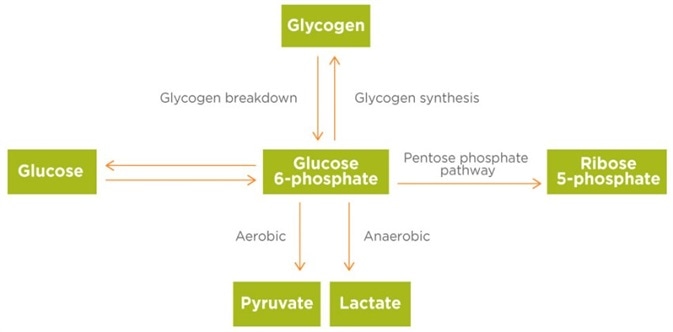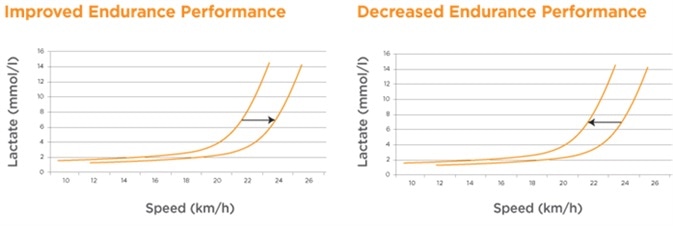
Image Credit: EKF Diagnostics
For a long time, muscular fatigue during exercise was believed to be caused primarily by lactate as a by-product of glycolysis (glucose metabolism).
In early studies, lactate was shown to increase in blood and muscle tissue dependent on exercise intensity and therefore there was a close correlation between lactate production and fatigue levels. These results are what led to this common misunderstanding.
It is necessary to understand the basics of glucose metabolism in order to fully understand the relationship between lactate levels and sports performance and training. Glucose is metabolized as an energy source during normal muscular activity to release energy with pyruvate with 2 H+ ions as a by-product.
Through something called aerobic glucose metabolism, further cellular energy sources are generated when pyruvate is utilized in other metabolic processes. Lactate becomes the preferred endpoint of glucose utilization as muscle activity increases and oxygen availability is limited for glucose metabolism. This is known as anaerobic glucose metabolism.

Image Credit: EKF Diagnostics
As the ultimate end product of glucose utilization within the body, lactate can be used in several ways. It can fuel the Krebs cycle once converted back to pyruvate. This ultimately produces the biochemical energy source ATP. It can also be converted to glucose through gluconeogenesis in the liver.
These other pathways are fuelled through active transport of lactate from muscle fibers into the bloodstream. Typical blood lactate levels at rest or during moderate exercise are approximately 1mM to 2 mM respectively. This means that, during rest or moderate activity, the body is able to use glucose, pyruvate and lactate as energy sources as well as precursors for other metabolic pathways.
Increasing glucose metabolism to fuel muscle activity is oxygen dependent during high intensity exercise. What’s more, there are downstream consequences with the switch to anaerobic glucose metabolism with lactate production as the endpoint. Muscles only have a limited capacity to utilize lactate and to remove lactate from muscle fiber. As such, lactate will begin to build up in the muscle fibers and eventually in the bloodstream.
The body’s utilization of lactate can be increased with training. This means that muscle function can be maintained for longer periods before lactate begins to build up in the muscles and subsequently in the blood.
Therefore, increased endurance is linked to an increased lactate threshold. The lactate threshold is defined as the first increase in blood lactate that is above resting level. This is usually between 1 and 2 mM in healthy subjects.
In order to develop aerobic and anaerobic metabolic pathways, athletes are required to carry out a mixture of speed work and slower endurance training. This is true for beginners and elite athletes alike. The lactate threshold test has been utilized in sports science to define specific training plans for various sports.
In the majority of these training plans distance and speed are increased gradually, so as not to overstress the body. This would start with 2 or 3 short midweek runs and a longer run at the weekend for recreational runners. As the weeks progress, these runs should get longer but be at a pace that is easily maintained and builds endurance at the same time.
A speed element will also be incorporated into training plans with the aim to reduce the time it takes to cover a given distance. Longer runs should be made up of a mixture of interval sessions, for example, by increasing the pace during the last minute of each mile. Speed specific sets should also be utilized. For example, 500 m with a 2 minute rest at an easy jog 4 times. Repeat this the following week and see if run times have improved. If they have improved, another set can be added or the distance increased and the recovery period reduced. These speed sessions should be at a moderate to moderately hard pace.
Lactate levels will usually be normal during a long runs at a pace that is sustainable. The body is pushed beyond the lactate threshold with speed work, which trains the body to better clear lactate from the musculature.
True lactate threshold training is the most efficient way to improve lactate threshold. Workouts are performed at a pace that is very close to an individual’s specific lactate threshold. This is usually a moderate to moderately hard pace. This intensity level is reached, for the vast majority of runners, at or just slightly slower than their 10K race pace.
It would be extremely hard and unadvised to train consistently at a pace as hard as lactate pace. The ideal way to increase an individual’s lactate threshold is through endurance-building long runs and stamina-building speed work at varying paces.
So How do I Perform a Lactate Threshold Test?
Typically referred to as step tests, they rely on stepping up the intensity of the exercise effort over 2, 3 or more steps.
A portable lactate meter, lactate sensors, lancets to take blood, a defined distance over which to run and a way of pacing oneself are all required to track an individual’s lactate threshold. A willing assistant would be of benefit, to take the blood sample and record the results.
A Simple Step Test Would Look Like this
- Take a blood lactate reading at baseline
- Run at an easy pace for 1200 m to warm up
- Take a second blood lactate reading
- Run at a slightly quicker pace for 1200 m
- Take a third blood lactate reading
- Run at a slightly quicker pace again for 1200 m
- Take a fourth blood lactate reading
- Run at a moderate to hard pace for the final 1200 m
- Take a fifth blood lactate reading
- Take a 5 min easy jog to cool down. Measure blood lactate every 2-3 minute during and after the cool down until the levels are back to the baseline level.
Why measure lactate in athletes
Video Credit: EKF Diagnostics
The important factor in the test is the pacing. It needs to be incremental but sustainable throughout the test. For this type of test, a watch with a pacing function is useful or training could be done on a treadmill with speed control.
Once the results are back the data needs to be analyzed. The portable blood lactate meter is supplied with software that will automatically pull data from the meter and plot the results.
This initial data indicates at what pace the lactate threshold was reached. This is likely to be at the second or third increase in pace. This then provides a pace to aim for and exceed in future speed sessions. The training plan should be continued using the pace data to inform the speed sessions.
The step test should be repeated with the same pacing 6-8 weeks later and the results compared in order to track progress. A move of the threshold to the right should be seen with the plotted data. This indicates that the blood lactate threshold has increased and higher paces can be run without accumulating lactate.

Image Credit: EKF Diagnostics
About EKF Diagnostics
EKF Diagnostics is a global medical diagnostics business with a long history in point-of-care testing and central laboratory manufacturing. Our products have a hard earned reputation for ease of use, reliability and accuracy.
Our core focus is the Point of Care market with over 80,000 haemoglobin, A1c, glucose and lactate analyzers in regular use in more than 100 countries running more than 50m tests every year.
Our range of HbA1c analyzers and glucose analyzers are used in GP surgeries, sports clinics, and diabetes clinics. They deliver fast and reliable results that provide both practitioner and patient with the information they need to make clinical or lifestyle decisions in minutes.
EKF Diagnostics offer the largest range of hemoglobin and hematocrit analyzers on the market, giving physicians and specialists a choice of product with different methodology, measurement speed, connectivity and price options. Our aim is to make blood donation and anaemia screening easier, more affordable and more accessible than ever before.
The EKF Maternal & Women’s Health Point of Care range aims to improve healthcare outcomes for women and children by providing physicians with a suite of products covering pregnancy testing, anaemia screening, fetal scalp lactate testing and post birth creamatocrit measurement.
EKF Diagnostics is also a global manufacturer of central laboratory products including Stanbio Chemistry reagents, benchtop laboratory analyzers, rapid tests and centrifuges. Our chemistry reagents can be used on the majority of analyzers found in hospital laboratories around the world.
The ordinary shares of EKF Diagnostics Holdings plc are traded on the AIM market of the London Stock Exchange.
Sponsored Content Policy: News-Medical.net publishes articles and related content that may be derived from sources where we have existing commercial relationships, provided such content adds value to the core editorial ethos of News-Medical.Net which is to educate and inform site visitors interested in medical research, science, medical devices and treatments.